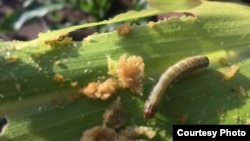The U.N. Food and Agriculture Organization (FAO) is holding an emergency regional meeting in Zimbabwe on the spread of armyworms in southern Africa, which is already struggling with food shortages. The pests are destroying crops in Malawi, Zimbabwe and Zambia.
FAO coordinator for southern Africa Chimimba David Phiri said the meeting is aimed at finding a strategy to contain the situation.
“Many countries are affected.... It is the countries that are going to offer solutions of a coordinated approach to control this. Now that we have this fall army worm, we cannot eradicate it. In the Americas, it has been there since 1957 and they have not managed to control it because it keeps evolving. So we cannot expect that it can be eradicated. But we have to find a plan for managing it from now onwards,” Phiri said.
Experts suspect that fall armyworm might have come when the southern African region imported maize from the Americas during a El Nino-induced drought in the 2015/2016 rain season.
The three-day meeting in Harare is also grappling with other plant pests such as the South American tomato leaf miner that has been found in Angola, Malawi, Mozambique, Namibia, South Africa, Tanzania, Zambia and Zimbabwe. The bug has caused extensive damage, according to International Red Locust Control Organization for Central and Southern Africa Director Moses Okhoba.
He says the east Africa region is also on high alert, amid the spread of H5N1, a highly pathogenic avian influenza in 12 west and central African countries, and H5N8 in wild and domestic birds along the shores of Lake Victoria, in Uganda. He says resources are being stretched.
“So we need to quickly think how quickly the region as a whole, not only in the outbreak areas, but also those states that are protected by the activities that are undertaken within the frontline states. So generally, I would say whatever we propose [at the meeting] in terms of protection is crucial to ensuring that food is secure in the region. Otherwise we end up with a disaster,” Okhoba said.
The FAO says more than 40 million people need food assistance in southern Africa before the next harvest that starts in March, with Zimbabwe and Madagascar being some of the worst hit by El Nino-induced drought.






